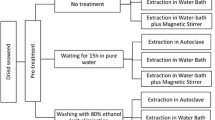Abstract
The suitability of four commonly used nutrient media, and two incubation temperatures for the bacteriological examination of purified water was investigated. The temperature of incubation (22 or 30°C) exerted no profound influence on the observed numbers of colony forming units. Five days was optimal for all incubation conditions. Tryptone Soya Peptone Broth Agar was found to be less productive than the other media investigated,viz. Nutrient Agar 1/8 strength. Nutrient Agar and King A medium, which appeared to be equally productive.
Similar content being viewed by others
References
United States Pharmacopoeia 20th ed. Rockville: United States Pharmacopoeial Convention Inc., 1980:851.
Nederlandse Farmacopee 8th ed. 's-Gravenhage: Staatsuitgeverij, 1978:153.
King EO, Ward MK, Raney DE. Two simple media for the demonstration of pyocyanin and fluorescence. J Lab Clin Med 1954;44:301–7.
Van der Kooy D. Vermeerdering van bacteriën in drinkwater. H2O 1981;14:317–23.
Abdou MA-F. In Pharmazeutika unerwünschte Mikro-Organismen I.Pseudomonas aeruginosa: Bedeutung, Vorkommen, Nachweis, und Bekämpfung. Pharm Ind 1973;35:857–67.
Mossel DAA, Ratto MA. Wholesomeness of some types of semi-preserved foods. J Food Technol 1973;8:97–103.
Wilcoxon F. Individual comparisons by ranking methods. Biometrics Bull 1945;51:80–3.
Morita RY. Psychrophilic Bacteria. Bact Rev 1975;39:144–67.
Ingram M, Mackey BM. Inactivation by cold. In: Skinner FA, Hugo WB, eds. Inhibition and inactivation of vegetative microbes. London: Academic Press, 1976;111–51.
Bruining M, Beekhuizen CCM, Hoevenaars PCM. Onderzoek naar de microbiologische kwaliteit van gedestilleerd water uit verschillende apotheken. Pharm Weekbl 1972;107:321–8.
Eisman PC, Kull FC, Mayer RL. The bacteriological aspects of deionized water. J Am Pharm Ass [Sci] 1949;38:88–91.
Faber DB, Meester HH. Microbiologische zuiverheid van demiwater. Pharm Weekbl 1972;107:329–36.
Leifson E. The bacterial flora of distilled and stored water. I. General observations, techniques and ecology. Int Bull Bact Nomencl Taxonomy 1962;12:133–53.
Leifson E. The bacterial flora of distilled and stored water. II.Caulobacter vibrioides, Henrici and Johnson 1935, in distilled water. Intern Bull Bact Nomencl Taxonomy 1962;12:155–9.
Leifson E. The bacterial flora of distilled and stored water. III. New species of the generaCorynebacterium, Flavobacterium, Spirillum, Pseudomonas. Int Bull Bact Nomencl Taxonomy 1962;12:161–70.
Wachi Y, Yanagi M, Katsura H, Ohta S. Decomposition of surface active agents by bacteria isolated from deionized water. J Soc Cosm Chem 1980;31:67–84.
Zimmermann G, Krüger D, Busse M. Die Bakterienflora von destilliertem und vollentsalztem Wasser und ihre Bedeutung bei der Herstellung von Arzneimitteln. Pharm Ind 1980;42:932–9.
Schure PSJ. Microbiologische zuiverheid van gedestilleerd water uit apotheken. Ned Tijdschr Geneeskd 1970;114:591–3.
Schure PSJ. Het bereiden en bewaren van gedestilleerd water voor de receptuur. Pharm Weekbl 1974;109:597–603.
Bühlmann X. Psychrophile Keime im Wasser: Verhalten und praktische Bedeutung. Alimenta 1970;9:22–9.
Postgate JR, Hunter JR. Accelerated death ofAerobacter aerogenes starved in the presence of growthlimiting substrates. J Gen Microbiol 1964;34:459–73.
Abdou MA-F. Sterilitätstest. Pharm Ind 1973;35:650–8.
Clausen OG. A study of the growth promoting properties of fluid and solid microbial-contamination test media on small numbers of micro-organisms. Pharm Acta Helv 1973;48:541–8.
Clausen OG, Aasgaard HB, Solberg O. Dithionitethioglycollate broth (HS-T Broth) a new control medium for microbial contamination tests of medical products. Ann Microbiol (Paris) 1973;124B:205–16.
Hein H, Neiss A. Vergleich verschiedener Nährlösungen zur Züchtung von Hefen. Pharm Ind 1971;33:75–8.
Bowman FW. The sterility testing of pharmaceuticals. J Pharm Sci 1969;58:1301–8.
Van Elburg-van Delft R, Mossel DAA, Corstiaensen GP, Van Ederveen W. An investigation into the nature and determination of the ‘total’ bacterial colonization of water of drinking water quality. Water Res, in press.
Author information
Authors and Affiliations
Rights and permissions
About this article
Cite this article
Van Doorne, H., Neuteboom, A. Comparison of media and temperature of incubation for microbiological examination of purified water. Pharmaceutisch Weekblad Scientific Edition 6, 105–110 (1984). https://doi.org/10.1007/BF01962999
Received:
Accepted:
Issue Date:
DOI: https://doi.org/10.1007/BF01962999




